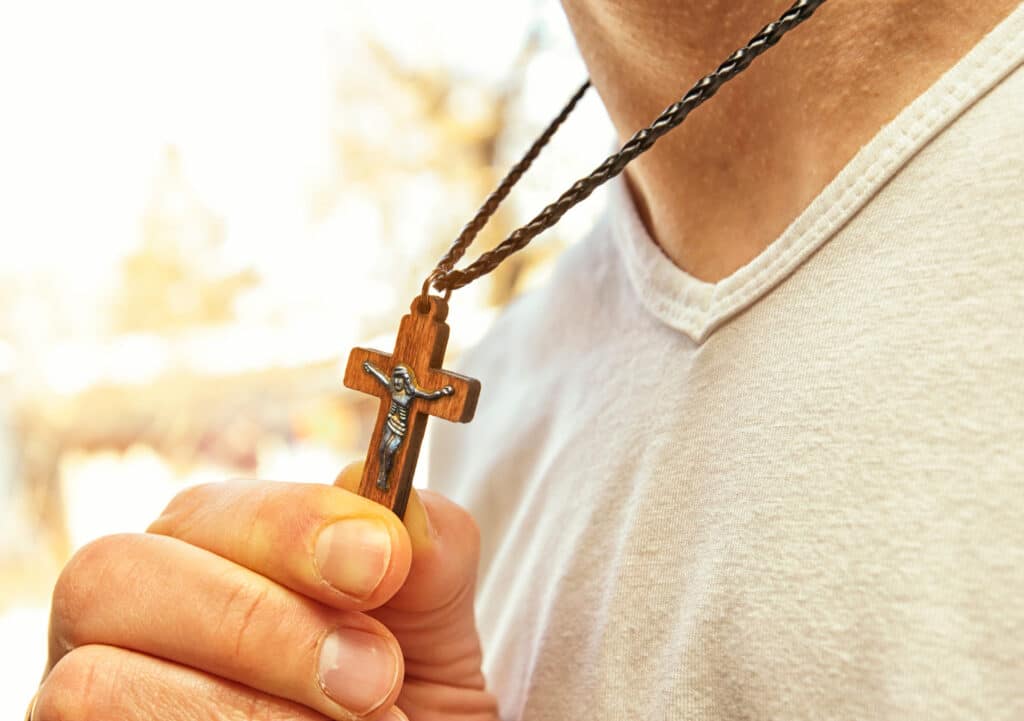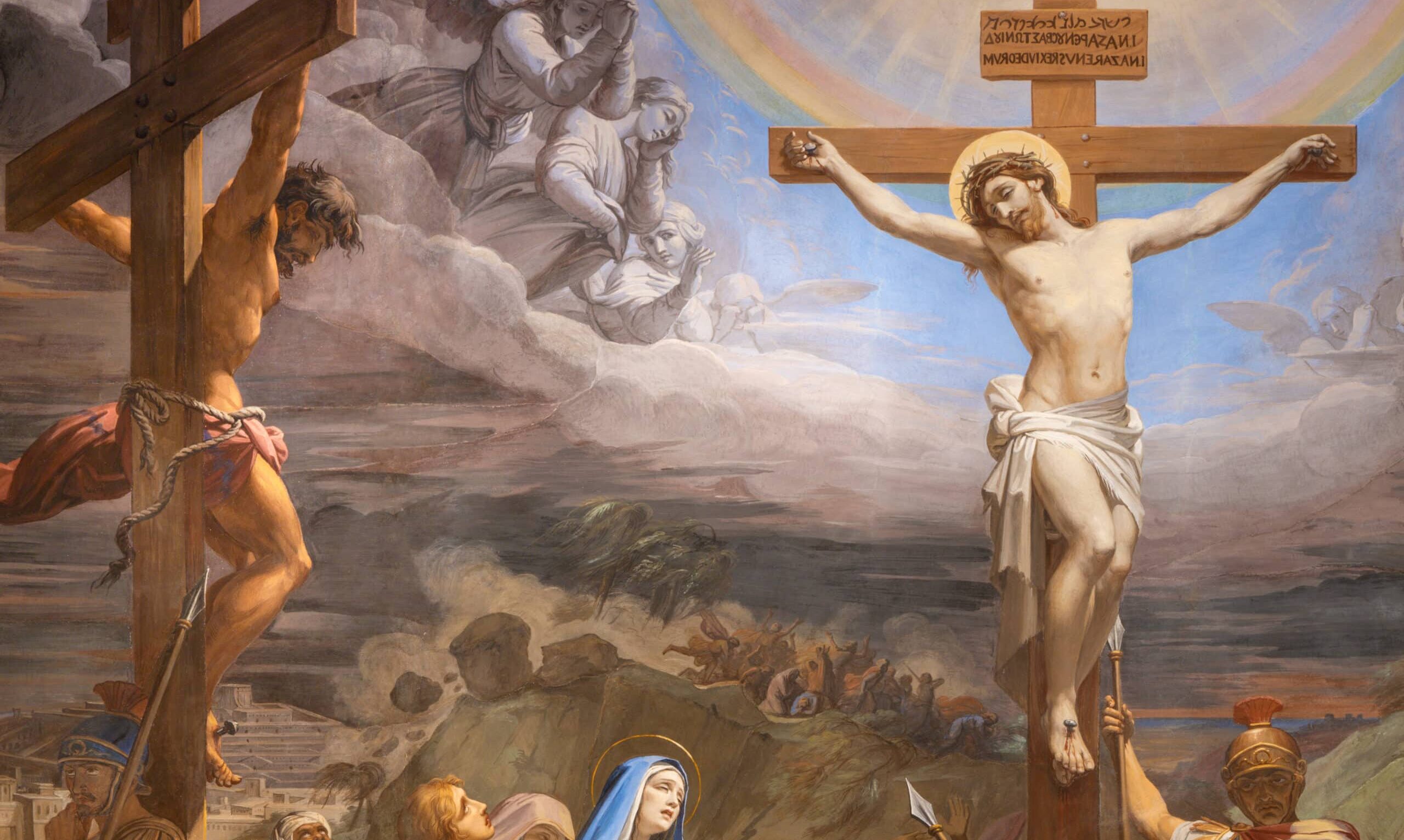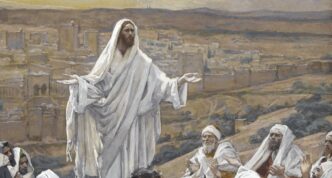This article first appeared in Our Sunday Visitor magazine. Subscribe to receive the monthly magazine here.
See, my servant shall prosper;
he shall be exalted and lifted up,
and shall be very high (Is 52:13).
Why is the cross the central symbol of our Catholic faith? Perhaps it’s not a question we’ve ever really thought about before. On the one hand, it’s hardly surprising that the cross, the outstanding sign of God’s love for us, would be a symbol of our faith. But on the other hand, the cross has become so much more than that. Today it is not merely one symbol among many, but the central symbol in our art, our devotion, our liturgy. On its face, this is rather strange.
Think about it for a moment. Christianity is about the Good News of what God has done for us through his Son. Given this, it seems that some other symbol would do a better job of summing up what Christianity is all about. Take a lamb, for instance. Wouldn’t an image of a nice, gentle, happy lamb be more effective at capturing the peace and joy of the Gospel than the image of a man dying on a cross? Or even better, consider the empty tomb. Surely the empty tomb would be a more fitting symbol of Christ’s victory over sin and death. Yet, for some reason, this is not the approach the Church took.
Instead, it is the cross that has become commonplace in our homes, in our churches, on highway billboards and even around our necks. In fact, most of us are so accustomed to seeing the cross in our everyday lives that we have ceased to be amazed by the astonishing scandal of what it represents. We forget that in the ancient world the cross was a symbol of unchecked violence and state-sponsored terror, a horrific torture device that embodied the domination of the strong at the expense of the weak.
The first Christians enjoyed no such luxury. For them, crucifixion was a fact of life, and they were keenly aware of the magnitude of the mystery it conveyed: the mystery whereby the God-man was subjected to the most shameful fate an ancient person could undergo, the ultimate loser’s death. If we pay attention, we can almost hear the trembling in Paul’s voice as he marvels at how Jesus “humbled himself / and became obedient to the point of death — / even death on a cross” (Phil 2:8). St. Paul and his fellow believers knew full well what we often miss: the utterly revolutionary nature of a faith that has the cross of Christ at its beating heart.
Crucifixion in the Roman world
If you were to ask anybody in the first century what they thought about starting a religious movement that took a guy dying on a cross as its central symbol, they would look at you like you were mad, sadistic or maybe both. And it’s not difficult to see why. In the ancient world, crucifixion was widely regarded as the most fearsome and gruesome form of death imaginable. The New Testament historian N.T. Wright offers a vivid description of what the horrifying spectacle typically involved:
And if you had actually seen a crucifixion or two, as many in the Roman world would have, your sleep itself would have been invaded by nightmares as the memories came flooding back unbidden, memories of humans half alive and half dead, lingering on perhaps for days on end, covered in blood and flies, nibbled by rats, pecked at by crows, with weeping but helpless relatives still keeping watch, and with hostile or mocking crowds adding their insults to the terrible injuries.
People living in the ancient world understood crucifixion for what it was: an agonizing cocktail of physical torture and ritual humiliation designed to prolong the dying process over many hours or even several days. For them, crucifixion was, quite literally, an excruciating fate — that’s where our English word originates: ex cruce, “from the cross.”
If crucifixion was an excruciating fate, it was also in many respects an unspeakable one. From ancient historians like Josephus, we know that tens of thousands of crucifixions took place within the Roman Empire. Yet the Romans themselves spent as little time as possible discussing the practice. The orator and statesman Cicero, for example, once described crucifixion as the “most cruel and loathsome punishment.” But he has no desire to dwell on the subject. As he explains in another work, “The very name of the cross should be far removed not only from the person of a Roman citizen, but also from his mind, his eyes and his ears.” For Cicero and his fellow elites, the sheer brutality of crucifixion — a brutality which made it such a useful tool for maintaining civil order — rendered it wholly unsuitable for conversation in polite society.
An analogy is helpful here. In a sense, the way the Roman elites viewed crucifixion was similar to the way modern elites talk about late-term abortion. Doubtless the movers and shakers in our culture are aware that tens of thousands of late-term abortions still take place in the United States every year. Presumably these elites believe these abortions to be essential for the stability and progress of modern society. At the same time, they realize the violence involved in the procedures is barbaric, so they avoid discussing the subject as much as possible. The embarrassed silence on the part of our modern elites is not dissimilar to the reticence the Romans felt toward the graphic realities of crucifixion in their own day.
The scandal of the cross
We are now in a better position to understand what it was like for the earliest Christians coming to terms with the Gospel message. As inhabitants of the Roman world, they knew full well the horrors of crucifixion and the seemingly outrageous idea of God becoming a human being and suffering a humiliating death on a cross. St. Paul reflected on this paradox in his first epistle to the Corinthian church, written a mere 20 years after the crucifixion of Jesus (1 Cor 1:21-25):
For since, in the wisdom of God, the world did not know God through wisdom, God decided, through the foolishness of our proclamation, to save those who believe. For Jews demand signs and Greeks desire wisdom, but we proclaim Christ crucified, a stumbling block to Jews and foolishness to Gentiles, but to those who are the called, both Jews and Greeks, Christ the power of God and the wisdom of God. For God’s foolishness is wiser than human wisdom, and God’s weakness is stronger than human strength.
St. Paul describes Christ crucified as a “stumbling block” to the Jews and “foolishness” to the Gentiles. The Greek words he uses are instructive: skandalon and mōrian. It doesn’t take a degree in classics to see that these are the roots of our English words “scandalous” and “moronic”! St. Paul is under no illusions about how the cross of Christ will appear to those who lack faith. And even for those who have faith, it will continue to present a challenge.
St. Paul’s words remind us that if we don’t feel shocked by the cross, then we haven’t really understood it yet. But for the earliest Christians, as we’ve seen, failing to be shocked by the cross was not an option. From the beginning they realized that the idea of the God-man hanging naked and broken on a tree was either the worst idea in history or else the only idea that could make sense of history. They understood that no part of creation — or of their daily lives — could be left unchanged by what God has done for us on the cross.
Even so, it would take several centuries before Christians felt comfortable making the cross the centerpiece of their imagery and art. Today we take it for granted that the cross is the central symbol of our faith, but it was not always so. In fact, art historians tell us that the oldest Christian crucifix that we possess dates from the early fifth century — a full 400 years after the death of Jesus! It was not until around A.D. 1000, moreover, that realistic depictions of the crucifixion became mainstream in Christian art.
This tells us that it was only after many centuries of suffering and reflection that the Church finally embraced the cross as her central and defining image. In time, she came to accept what we often take for granted today: that it is the cross that best sums up the essence of our Christian faith. But still, we might be wondering, why did the Church reach this conclusion? Why is it the cross — and not some other symbol like the empty tomb — that takes pride of place in our imagery and art?
Clues in John’s Gospel
In order to answer these questions, it is necessary to meditate more deeply on what the cross actually means. Here we can find no better guide than John’s Gospel, which offers a roadmap for understanding why the cross is so central to our Catholic faith. Repeatedly in the fourth Gospel, Jesus speaks of a future time when he will be lifted up: “And just as Moses lifted up the serpent in the wilderness, so must the Son of Man be lifted up … ” (Jn 3:14). “When you have lifted up the Son of Man, then you will realize that I am he … ” (Jn 8:28). “And I, when I am lifted up from the earth, will draw all people to myself ” (Jn 12:32).
With these statements, Jesus calls to mind the experience of the suffering servant in the Book of Isaiah: “See, my servant shall prosper; / he shall be exalted and lifted up, / and shall be very high” (Is 52:13). In borrowing the words from Isaiah, Jesus makes a deliberate play on words. On the one hand, he prophesies his crucifixion (and, later, his ascension), when he will be physically lifted up from the earth. But in a deeper sense, he points forward to the glorious exaltation — a spiritual lifting up — that he will undergo on Calvary.
What makes John’s Gospel particularly startling is the fact that both forms of lifting up occur simultaneously. The evangelist is not simply arguing that because Jesus is lifted up physically on the cross, therefore he will be exalted at some later date. No, for St. John it is essential for us to understand that Christ’s crucifixion is his exaltation. In other words, Christ’s glory is unveiled not just in his resurrection and ascension, but also in the passion and death that preceded them.

We’ve already quoted Christ’s words about drawing all people to himself through his crucifixion. The exchange that serves as the background to that statement (Jn 12:20-24) is also worth revisiting:
Now among those who went up to worship at the festival were some Greeks. They came to Philip, who was from Bethsaida in Galilee, and said to him, “Sir, we wish to see Jesus.” Philip went and told Andrew; then Andrew and Philip went and told Jesus. Jesus answered them, “The hour has come for the Son of Man to be glorified. Very truly, I tell you, unless a grain of wheat falls into the earth and dies, it remains just a single grain; but if it dies, it bears much fruit.”
At first glance, this passage feels rather strange. When Andrew and Philip inform Jesus that some Greeks want to see him, Jesus’ response seems unrelated to what they just said. We might even be tempted to think that Jesus is dismissing the Greeks’ request as unimportant. But a closer reading suggests there is more going on than meets the eye: rather than giving the Greeks the quick “yes” or “no” they desire, Jesus instead chooses to answer their question in a deeper way.
Consider how he begins his response: “The hour has come for the Son of Man to be glorified.” It sure sounds like he is dodging the question. But what if he isn’t dodging? What if he is giving precisely the answer that the Greeks — and us — need to hear? We know that throughout John’s Gospel, “the hour” refers primarily to the hour of Christ’s passion. Yet this leads us to a startling conclusion: In response to the request to see him, Jesus points to the cross. Audacious but true, the radical claim of John’s Gospel is that the moment when Jesus’ identity will be seen most clearly is when he hangs naked and bloody from a tree, because that is when he will most perfectly reveal the infinite, self-giving love of the Trinity.
Take up your cross
The Lord Jesus would have us realize that his sacrifice on the cross is nothing less than an epiphany of divine glory. And yet, the very next words out of his mouth are a reminder that seeing him on the cross is only the beginning of what it means to follow him. With great solemnity he warns us, “Very truly, I tell you, unless a grain of wheat falls into the earth and dies, it remains just a single grain; but if it dies, it bears much fruit.”
We find here an echo of Jesus’ exhortation, recorded in all three synoptic Gospels, for his would-be followers to “deny themselves and take up their cross and follow me” (Mt 16:24; cf. Mk 8:34, Lk 9:23 and 14:27). For Christ’s first-century listeners, these words would have sounded jarring in the extreme. Crucifixion was not only a stark fact of life — for many of them, it was a very real threat. These early Christians had to learn the hard way the same lesson Jesus extends to us: We see his exaltation when he offers himself for us on the cross, but we share in his exaltation by making his cross our own.
St. Paul affirms this point in his Epistle to the Romans: “We are children of God, and if children, then heirs, heirs of God and joint heirs with Christ — if, in fact, we suffer with him so that we may also be glorified with him” (Rom 8:16-17). Christianity is not a spectator sport. In a very real sense, becoming a disciple of Christ means recognizing that our old self, so in love with the ways of the world, must be nailed to the wood of the cross. Only then can we discover true and lasting happiness; only then can our souls bear much fruit.
Perhaps this all sounds rather daunting — and in a sense, so it should. Left to our own devices, the task of following Christ is not just daunting; it’s downright impossible. But the good news of the Gospel is that we are not left to our own devices. Jesus promises us the grace to do that which we cannot do on our own. From the cross he draws us to himself, inviting us to share in his afflictions so that we might also share in his exaltation.
Here we find the solution to the question with which we began. The cross is the central symbol of our Catholic faith because the way of the cross is what you and I are called to. And so we lift high the cross — in our world and in our hearts — in celebration of the one who took that ancient symbol of terror and torture and transformed it into an icon of divine love.








